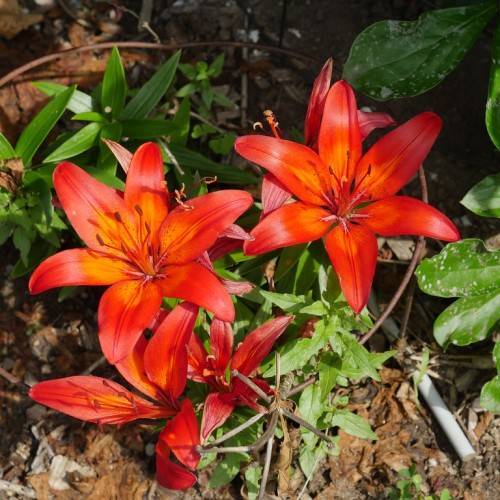
lily
Lilium 'Sunset'
Cycle:
Perennial
Watering:
Average
Hardiness Zone:
4 - 8
Flowers:
Flowers In Summer
Sun:
Full sun,part shade
Leaf:
Yes
Growth Rate:
High
Maintenance:
Low
Drought Tolerant:
Yes
watering
Lilies (Lilium 'Sunset') should be watered regularly. To ensure the best results, water when the potting soil has dried out slightly. In general, lilies need to be watered every 7-10 days. For best results, use filtered or rainwater rather than tap water, as tap water can contain salts that can build up and harm the plant. During the warmer summer months, watering more frequently may be necessary. Start by watering the base of the plant, letting the water seep down through the soil. When finished, the soil should be lightly moist but not soaked.
sunlight
Lily plants are sun-loving and thrive best when planted in areas with full sun, at least 6 to 8 hours of direct sunlight per day. 'Sunset' lilies are especially suited to warm climates, where the temperature ranges between 65-85°F and the sun is at its peak. They do not tolerate cold temperatures so should be placed in an area sheltered from the wind. To ensure your lily blooms at its peak, try to provide 6–8 hours of direct sunlight each day.
pruning
Lily (Lilium 'Sunset') should be pruned in late autumn or early winter, after flowering is finished. Pruning lilies helps to reduce disease problems and improves overall flower size and quality. To prune, remove any dead or damaged leaves and stems, then trim the plant back to a few inches above the ground. Make sure to make the cut clean and evenly, as any rough or jagged edges can invite disease. To promote good air circulation, thin the number of stems, removing the weakest or oldest ones. Lily bulbs can also be divided in the fall in order to create healthier, more fruitful plants.
Season
Hardiness Map
FAQ
Are peace lily plants toxic to pets?
Yes, peace lily plants are toxic to pets. Both cats and dogs can suffer from vomiting, drooling, and difficulty swallowing if they ingest any part of the peace lily plant. In severe cases, pets may also experience difficulty breathing or an increased heart rate due to the ingestion of the poisonous plant. If you believe your pet has ingested any part of the Peace Lily, it is advisable to contact a vet immediately.
Can peace lily plants bloom indoors?
Yes, Peace Lily plants are well suited to indoor conditions and they do bloom indoors. The Peace Lily plant is easy to care for, and a small Peace Lily in a pot will typically bloom one to two times per year. The Peace Lily flower is white and smells slightly sweet, making it a nice addition to any home. Keep in mind that the Peace Lily requires a lot of humidity, so it may be necessary to mist it occasionally and place near a humidifier.
Should I place my peace lily in direct sunlight?
No, peace lilies don't prefer direct sunlight and should not be placed in it. Ideally, they should be placed in indirect or filtered light, like near a south-facing window. This will provide enough light for the plant while protecting it from the harsh sun, which could cause its leaves to burn and turn yellow.
Is the average lifespan of a peace lily known?
The average lifespan of a peace lily is not definitively known, although generally the flowers can survive for up to 10 years or more. To ensure the longevity of a peace lily, it is important to maintain regular watering and light exposure to keep the plant healthy and prevent it from wilting. Additionally, if the peace lily is regularly pruned and groomed, with dead leaves and old flowers being removed, it can help to extend the life of the flower.
should I water my peace lily plant every day?
No, you should not water your peace lily plant every day. These plants prefer to have their soil on the drier side and are prone to root rot if overwatered. Water your peace lily about once a week, and be sure to monitor the top inch of the soil for dryness before watering. If the top inch of soil is still damp, wait a few days before you water your plant to prevent overwatering.
Could Daylilies be used for cut flowers?
Yes, Daylilies can be used for cut flowers. Daylilies are known for being hardy and easy to care for due to their strong root systems and long-lasting blooms. Not only is their unique look and variety of colors attractive, but they also last for about a week in a vase. Furthermore, Daylilies have an interesting scent that makes them a great addition to any flower arrangement.
